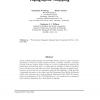Free Online Productivity Tools
i2Speak
i2Symbol
i2OCR
iTex2Img
iWeb2Print
iWeb2Shot
i2Type
iPdf2Split
iPdf2Merge
i2Bopomofo
i2Arabic
i2Style
i2Image
i2PDF
iLatex2Rtf
Sci2ools
NECO
1998
1998
GTM: The Generative Topographic Mapping
Latent variable models represent the probability density of data in a space of several dimensions in terms of a smaller number of latent, or hidden, variables. A familiar example is factor analysis which is based on a linear transformations between the latent space and the data space. In this paper we introduce a form of non-linear latent variable model called the Generative Topographic Mapping for which the parameters of the model can be determined using the EM algorithm. GTM provides a principled alternative to the widely used Self-Organizing Map (SOM) of Kohonen (1982), and overcomes most of the significant limitations of the SOM. We demonstrate the performance of the GTM algorithm on a toy problem and on simulated data from flow diagnostics for a multi-phase oil pipeline. Copyright c MIT Press (1998).
| Added | 22 Dec 2010 |
| Updated | 22 Dec 2010 |
| Type | Journal |
| Year | 1998 |
| Where | NECO |
| Authors | Christopher M. Bishop, Markus Svensén, Christopher K. I. Williams |
Comments (0)

